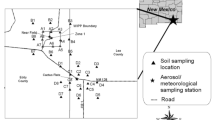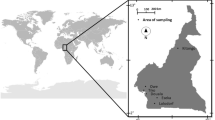Abstract
The activities of 133Ba, 137Cs, 152Eu, 154Eu, 155Eu, 239Pu, and 241Am were determined by gamma spectroscopy on the largest sample set (n = 49) of bulk trinitite to date. The range in activity for all isotopes is large. For example, the activity of 241Am (normalized to the time of detonation) ranges between 1 and 42 Bq/g. Comparison of activities for isotopes derived from the device, 241Am versus 137Cs, 155Eu, and 239Pu, indicate positive trends. Correlations were not observed between the activities of the soil-derived activation products 152Eu and 154Eu and the radioisotopes from the device. The calculated ratio of fission products (155Eu/137Cs) is 0.012 ± .006 (1σ, n = 3), which is lower than predicted for the thermal neutron-induced fission of 239Pu (~0.03). This discrepancy may be attributed to the spontaneous fission of the natural U tamper resulting in mixing between fission products from 239Pu and 235U. The spatial distribution of the trinitite samples relative to ground zero has been modeled based on the activity of 152Eu. The calculated distances do not correlate with any of the activities for the radioisotopes investigated here, and suggest a relatively homogeneous distribution. However, trinitite samples with the highest activities for 137Cs, 239Pu, and 241Am yield the shortest calculated distances of 50–60 m away from ground zero.






Similar content being viewed by others
References
Fahey AJ, Zeissler CJ, Newbury DE, Davis J, Lindstrom RM (2010) Postdetonation nuclear debris for attribution. Proc Nat Acad Sci 107(47):20207–20212
Parekh PP, Semkow TM, Torres MA, Haines DK, Cooper JM, Rosenburg PM, Kitto ME (2006) Radioactivity in trinitite six decades later. J Environ Radioact 85:103–120
Eby N, Hermes R, Charnley N, Smoliga JA (2010) Trinitite-the atomic rock. Geol Today 26(5):180–185
Staritzky E (1950) Thermal effects of atomic bomb explosions on soils at Trinity and Eniwetok. Los Alamos Scientific Laboratory, LA-1126, p 21
Storms B (1965) Trinity. The Atom 2(8):1–34
Rhodes R (1986) The making of the atomic bomb, 1st edn. Simon and Schuster, New York, pp 575–577, 657
Wahl AC (1988) Nuclear-charge distribution and delayed-neutron yields for thermal-neutron-induced fission of 235U, 233U, and 239Pu and for spontaneous fission of 252Cf. At Data Nucl Data Tables 39:1–156
Semkow TM, Parekh PP, Haines DK (2006) Modeling the effects of the trinity test. Appl Model Comput Nucl Sci 945:142–159
Bainbridge KT (1976) Trinity Report LA-6300-H. Los Alamos Scientific Laboratory, Los Alamos
Belloni F, Himbert J, Marzocchi O, Romanello V (2011) Investigating incorporation and distribution of radionuclides in trinitite. J Environ Radioact 102:852–862
Love DW, Allen BD, Myers RG (2008) Gypsum crystal morphologies and diverse accumulations of gypsum and other evaporites in the Tularosa basin. New Mexico Geol 30:120–121
Bellucci JJ, Simonetti A (2012) Nuclear forensics: searching for nuclear device debris in trinitite-hosted inclusions. J Radioanal Nucl Chem 293:313–319
US GPO (2000) Trinity site July 16, 1945. US Government Printing Office: 2000–844-916, Washington DC
Brunfelt AO, Roelandts I, Steinnes E (1977) Some new methods for the determination of rare-earth elements in geological materials using thermal and epithermal neutron activation. J Radioanal Chem 38:451–459
Klema ED (1945) July 16th nuclear explosion: neutron measurements with gold-foil detectors. Los Alamos Scientific Laboratory report, LA-362
Schlauf D, Siemon K, Weber R, Esterlund RA, Molzahn D, Parzelt P (1997) Trinitite redux: comment of “Determining the yield of the Trinity nuclear device via gamma-ray spectroscopy” by David Arkatz and Christopher Bragg. American Journal of Physics. 65(11), 1110–112. Am J Phys 63:411–413
Liede DR (ed) (2003) CRC handbook of chemistry and physics, 84th edn. CRC Press, Boca Raton
Shoupp WE, Hill JE (1949) Thresholds for fast neutron fission in thorium and uranium. Phys Rev 75(5):785–789
Acknowledgments
The authors thank the separations and radiochemistry research team at Pacific Northwest National Laboratory and Dr. Ed Stech in the Department of Physics at the University of Notre Dame for thoughtful discussions. This research work was funded by DOE/NNSA grant PDP11-40/DE-NA0001112.
Author information
Authors and Affiliations
Corresponding author
Electronic supplementary material
Below is the link to the electronic supplementary material.
Rights and permissions
About this article
Cite this article
Bellucci, J.J., Wallace, C., Koeman, E.C. et al. Distribution and behavior of some radionuclides associated with the Trinity nuclear test. J Radioanal Nucl Chem 295, 2049–2057 (2013). https://doi.org/10.1007/s10967-012-2201-4
Received:
Published:
Issue Date:
DOI: https://doi.org/10.1007/s10967-012-2201-4




